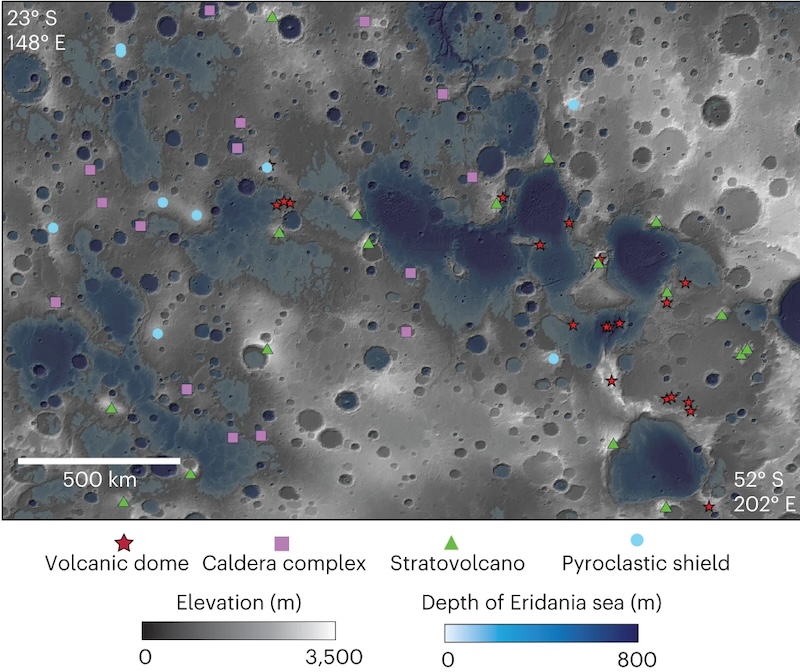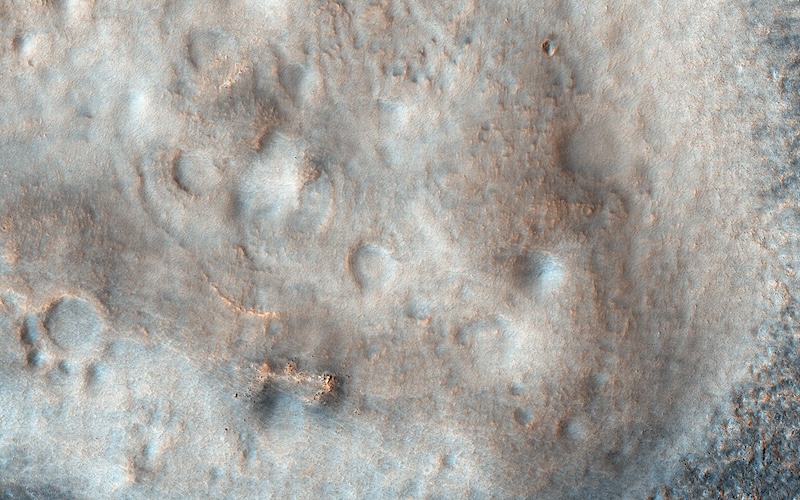
- Mars has gigantic volcanoes, bigger than those found on Earth. But Mars lacks the kind of plate tectonics that drives earthly volcanoes. So what caused the volcanoes on Mars?
- It seems that vertical tectonics might have driven Mars’ volcanoes. In other words, instead of a sideways movement of land plates as on Earth, Mars’ crust might have undergone an up-and-down movement (uplift and subsidence).
- The work suggests more diversity in Martian volcanoes than scientists once thought.
Mars is known for its volcanoes, some of which dwarf the largest volcanoes on Earth. And, although Mars’ volcanoes have been extinct or dormant for millions of years, there’s growing evidence for some residual volcanic activity still happening underground on Mars today. Most known Martian volcanoes resemble the shield volcanoes found in Hawaii. But on February 15, 2024, scientists in China and the U.S. said ancient volcanism on Mars was more diverse than previously thought.
They said the early volcanism on Mars likely wasn’t driven by the sort of plate tectonics we have on Earth today (the sideways movement of great land plates over time, resulting in volcanoes and earthquakes). Instead, on early Mars, volcanism might have resulted from what geologists call vertical tectonics. That is, on Mars, the land shifts not sideways, but up and down.
According to these scientists, their work also provides clues to pre-tectonic plate crust recycling and volcanism on the early Earth.
The researchers published their peer-reviewed findings in Nature Astronomy on February 12, 2024.
Volcanism on Mars still not well understood
Mars was certainly highly volcanically active in the past. We know that from its numerous volcanoes, such as the giant ones on the Tharsis Bulge, including the mighty Olympus Mons.
But scientists still don’t fully understand the processes involved. That’s because Mars lacked plate tectonics, which, through heat and crustal recycling, fuels volcanic activity on Earth.
So how was Mars able to be so active?
Most of the known Martian volcanoes are huge basaltic shield volcanoes, similar to the ones in Hawaii, for example. But now, the new findings reveal that other kinds of volcanoes were once active as well. The ancient shield volcanoes are easy to see, but other smaller types may be harder to find. Scientists have, however, tentatively identified mud volcanoes before.
Ancient volcanoes on Mars more diverse than previously thought
Joseph Michalski, a geologist at the University of Hong Kong (HKU), led the new research into Martian volcanism. He and his colleagues have found evidence for a much wider range of ancient volcanism on Mars than previously known. The study focused on the Eridania Basin on Mars, which scientists say was an ancient lake or seafloor. The researchers said that an early form of crustal recycling called vertical tectonics, or vertical displacement, fueled this volcanism. He explained:
We have known for decades that Mars has volcanoes, but most of the recognized volcanoes correspond to large basaltic shield volcanoes similar to the ones that make up Hawaii. In this work, we show that the ancient crust has many other types of volcanoes such as lava domes, stratovolcanoes, calderas and large shields of ash, not lava. Further, most scientists see Mars as a planet composed of basalt, which has low silica content and represents little crustal evolution, but these volcanoes have high silica content, which means they formed from a complex process of magma evolution not known before.
The paper further stated:
Mars has generally been considered a one-plate basaltic planet, though recent evidence suggests magmatic evolution resulting in felsic crust might have occurred sporadically. Here we show multiple lines of evidence for diverse volcanism and complex volcanotectonics in the southern highlands of Mars within and around the 3.5- to 4-billion-year-old Eridania basin.

Silica-rich magma
If Mars rocks are normally low in silica, then how did these volcanoes become enriched in it? The researchers said that the most likely answer is vertical tectonics. In this scenario, the planet was highly volcanically active, so much so that the crust collapsed into the mantle below in spots. As a result, the rocks re-melted, forming silica. So even without plate tectonics, Mars was still a volcanically active world.
Michalski said:
Mars contains critical geological puzzle pieces that help us understand not only that planet, but the Earth as well. Martian volcanism is much more complex and diverse than has been previously thought. This is a significant discovery because it has revealed that crustal recycling can occur not only in plate tectonic regimes dominated by horizontal movements, but can also occur in pre-plate tectonic regimes dominated by vertical movements. This finding can help earth scientists revolve the long-term controversial issues of how and when felsic continents formed in our planet (Earth).

Current active volcanoes on Mars?
In terms of active volcanism, Mars’ volcanoes no longer emit lava or ash. There is, however, evidence for some residual volcanic activity underground. NASA’s InSight lander detected hundreds of marsquakes in the subsurface, showing that Mars is still seismically active.
Some of those quakes were detected near or at Cerberus Fossae, a location where scientists have found geologically young lava deposits. Eruptions may have occurred here as recently as 53,000 years ago. This means that Mars may still be volcanically active to some degree underground.
Bottom line: Researchers in China and the U.S. said ancient active volcanoes on Mars were more diverse than previously known, despite a lack of plate tectonics.
Source: Diverse volcanism and crustal recycling on early Mars
Via The University of Hong Kong











